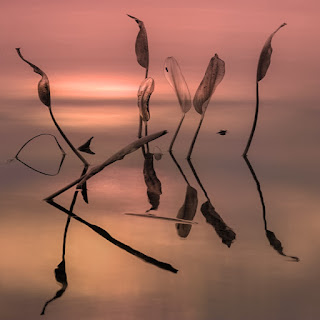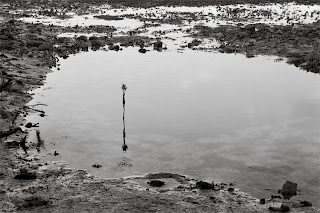
A young photographer recently asked me one of those "deceptively difficult" questions one encounters from time to time. While not quite in the unanswerable category that questions such as "So, what is life all about?" fall into, I was nonetheless hard pressed to give a quick respond to this question: "What are the most important lessons you've learned on your way to becoming a fine-art photographer?"
Leaving aside the temptation to reply either that "I'm not quite sure I'm a fine-art photographer yet, so..." or, perhaps, "I have no idea, but when you get a good answer from someone, please come back to share it with me!"...after some sober reflection, I decided that if I have anything of value to impart at all, after 35 or so years of struggling to find my own "eye/I" in photography, the basic lessons are these:
1. Never stop taking pictures. Always take pictures, constantly, even when you dont have a camera with you. Always pretend you have an imaginary lens in front of your eyes, and let them dart back and forth wherever you are; looking, seeing, composing, relating one part of a scene to another, imagining what it may look like with one filter or another, that lens instead of this one, and so forth. Don't let a day go by without at least the mental exercise of picture taking; better yet, wander around with a camera for an hour or two every day and take pictures. Photography is at least as much a lifestyle as it is a craft! If you are passionate about photography, you will photograph; you have to, it's who you are. Whether an interest in photography (or any creative endeavor for that matter) is a passing fancy or a deep passion can easily be determined by noting the extent to which you miss it when circumstances prevent you from practicing it. If the passion is real, you will begin (sometimes very creatively;-) sculpting your time to make sure you always have time for your art. The passion lives to the extent that you provide it with the one thing it needs: taking pictures, always taking pictures.
2. Forget about things and concentrate on feelings. Photography - especially fine-art photography - is the art of using the objective reality that sits squarely before you and your eye, and whatever means are at your disposal (beginning with your choice of where to look and what to leave out of a composition), to try to communicate to someone days, weeks, years later the feeling that came over you the instant you paused and said, to yourself, "Ah, I must take a picture!" This is something that is both very, very hard to explain how to do (indeed, I'm not even attempting to do that here), and will eventually become something that is very, very obvious to you about what you are really "doing" as a fine-art photographer (even if, as in my case, you fail at it much more often than you succeed).
"I do not photograph nature. I photograph my vision." -
Man Ray
One day you will look at your own images, or better, look at someone else looking at your pictures, and you'll understand that you've become a photographer, not a snapshooter. You will realize that some image of yours actually made someone else feel pretty much what you felt while taking it. This is the essential core truth of all meaningful art, and is the first real step toward defining yourself as an artist.
3. Do not internalize (or take too seriously) what others tell you about your pictures; take the pictures that are important to you. Use your images as a way of going inward, into your own soul. Photography is first and foremost a process of self-discovery, not an exercise in literal capture of something "out there". Photojournalism aside (since my focus is on fine-art photography), the most timeless images of all are those that somehow capture a few notes of a deep universal rhythm; you know you're close when you see a part of yourself looking back.
“A man sets out to draw the world. As the years go by, he peoples a space with images of provinces, kingdoms, mountains, bays, ships, islands, fishes, rooms, instruments, stars, horses, and individuals. A short time before he dies, he discovers that the patient labyrinth of lines traces the lineaments of his own face.” –
Jorge Luis Borges, Afterword to El Hacedor (aka
Dreamtigers), 1960
The paradox is that it is only by looking inward, at who we are, and communicating to the world what we see and feel, that we stand the best chance of capturing a truth (and beauty) that others will recognize as their own. The least promising way to go about this is to take pictures that satisfy someone else's vision. While one may still manage to take technically well executed photographs, chances are slim that they will be infused with any deep meaning.
4. Learn the basics of technique, so that "technique" never again requires your conscious attention. While it's certainly important to develop the necessary skills of any craft, and photography is no exception, learn them well and internalize them, but then quickly move on to the art. It is far easier for a creative spark to emerge out of a sincere (but perhaps technically deficient) soul, than it is for art of any kind to arise in an atmosphere where the technical aspects reign supreme.
"Technique is what you fall back on when you are out of inspiration." -
Rudolf Nureyev
If you put a homemade pinhole camera into the hands of a master photographer who has never used one, after a bit of fiddling, he or she is likely to produce the same fine-art caliber of imagery - with exactly the same depth of feeling - that he or she naturally creates. But put a world-class $15,000 Hasselblad in the hands of someone with "a photography degree", who perhaps knows more about what each button and dial does than the designers of the camera, but has little real passion for the art, and all you're likely to get is a snapshot taken with a $15,000 Hasselblad. The focus must always be on the art, and what you're trying to communicate with it; the technical side is there only to support you, and will take care of itself.
5.
Never stop learning from the masters, and their photographs. Look at their work, and then again, and again; never stop looking at what
other photographers you admire (and don't admire!) have done. I have never known a fine-art photographer that does not have a veritable library of books by other photographers (and I will share some of those in my collection in a later post). These are our teachers. They inspire us, they educate us, they provide us with ideas and stepping stones for us to forge our own path toward self-discovery. Second hand bookstores are a great treasure, as people tend to throw away the "old" uninteresting stuff. What a goldmine of inspiration I say! Keep looking, keep flipping though art books, and don't confine yourself to photography by the way. Art is art, whatever the medium. Everything I learned about composition, tone, form and texture - and, ultimately, about photography itself - I learned simply though watching my
dad, who (though not a photographer) was a
remarkable artist.
6.
Forge your own path (strong form of lesson #3). The most difficult lesson of all, certainly the most difficult to follow, is to know that we will ultimately achieve little of lasting value if our work does not bear the fruit of our own uniqueness. How do you know you're on the right path? As
Joseph Campbell wisely reminds us,
"If the path before you is clear, you're probably on someone else's." This does not mean that your work cannot be "derivative" (or be labeled as such by others); it does not mean it cannot come "easily" (though only a lucky few ever experience it as such); and it does not mean you must always be "lost in the jungle" to stay away from every well-trodden path you see in the distance. It means only that whatever form your art assumes, that it arises
naturally,
from within, and sincerely expresses your unique vision. Ineffably, you cannot ask for it. You cannot choose it. You cannot guess it. You cannot will it. You cannot blindly hope it comes to you. But have faith in the humble truth that - if you are an artist, and your soul is pure and true to itself - your "vision" will find
you, and when it appears,
you will have found yourself.
"Art...comes inevitably as the tree from the root, the branch from the trunk, the blossom from the twig. None of these forget the present in looking backward or forward. They are occupied wholly with the fulfillment of their own existence. The branch does not boast of the relation it bears to its great ancestor the trunk ...because it is engaged in the full play of its own existence, because it is full in its own growth, its fruit is inevitable." - Robert Henri, The Art Spirit





















